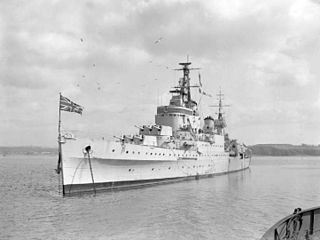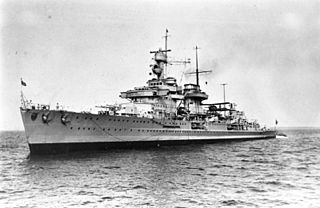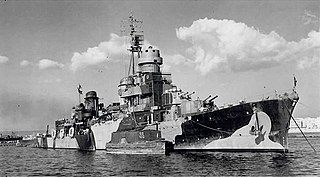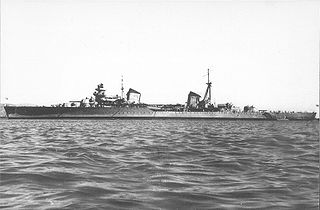
A torpedo boat is a relatively small and fast naval ship designed to carry torpedoes into battle. The first designs were steam-powered craft dedicated to ramming enemy ships with explosive spar torpedoes. Later evolutions launched variants of self-propelled Whitehead torpedoes.

The seventh HMS Newcastle was a member of the Southampton subclass of the Town-class light cruiser of the Royal Navy.

The Romanian Naval Forces is the principal naval branch of the Romanian Armed Forces and operates in the Black Sea and on the Danube. It traces its history back to 1860.

The Battle of the Mediterranean was the name given to the naval campaign fought in the Mediterranean Sea during World War II, from 10 June 1940 to 2 May 1945.

Nürnberg was a German light cruiser of the Leipzig class built for the Kriegsmarine. She was named after the city of Nuremberg and had one sister ship, Leipzig. Nürnberg was laid down in 1934, launched in December of that year, and completed in November 1935. She was armed with a main battery of nine 15 cm (5.9 in) guns in three triple turrets and could steam at a speed of 32 knots. Nürnberg was the longest-serving major warship of the Kriegsmarine, and the only one to see active service after the end of World War II, though not in a German navy.

The Capitani Romani class was a class of light cruisers acting as flotilla leaders for the Regia Marina. They were built to outrun and outgun the large new French destroyers of the Le Fantasque and Mogador classes. Twelve hulls were ordered in late 1939, but only four were completed, just three of these before the Italian armistice in 1943. The ships were named after prominent ancient Romans.

Horia Macellariu was a Romanian rear admiral, commander of the Royal Romanian Navy's Black Sea Fleet during the Second World War.
The Black Sea Campaigns were the operations of the Axis and Soviet naval forces in the Black Sea and its coastal regions during World War II between 1941 and 1944, including in support of the land forces.

The Battle of Cape Passero (1940), was a Second World War naval engagement between the British light cruiser HMS Ajax and seven torpedo boats and destroyers of the Italian Regia Marina, southeast of Sicily, in the early hours of 12 October 1940. It took place in the aftermath of a British supply operation to Malta.

Molotov was a Project 26bis Kirov-class cruiser of the Soviet Navy that served during World War II and into the Cold War. She supported Soviet troops during the Siege of Sevastopol, the Kerch-Feodosiya Operation and the amphibious landings at Novorossiysk at the end of January 1943.

The explosive motorboat MT also known as barchino, was a series of small explosive motor boats developed by the Italian Royal Navy, which was based on its predecessors, the prototype boat MA and the MAT, an airborne prototype. Explosive motorboats were designed to make a silent approach to a moored warship, set a collision course and run into full gear until the last 200 or 100 yards to the target, when the pilot would eject after blocking the rudder. At impact, the hull would be broken amidships by a small explosive charge, sinking the boat and the warhead, which was fitted with a water-pressure fuse set to go off at a depth of one metre.

Leone Pancaldo was one of twelve Navigatori-class destroyers built for the Regia Marina between the late 1920s. Shortly after Italy's entry into World War II in June 1940, she was sunk by British torpedo bombers in Augusta, Sicily, but was later refloated and repaired. She was briefly used in fast troop transport missions to Tunisia until her second and final sinking by Allied aircraft in April 1943.

Operation Scylla was the transit of the Regia Marina Capitani Romani-class light cruiser Scipione Africano on the night of 17/18 July 1943, during the Second World War. The cruiser sailed from La Spezia in the Tyrrhenian Sea to Taranto in the Ionian Sea during the Allied invasion of Sicily.
The Romanian Navy during World War II was the main Axis naval force in the Black Sea campaigns and fought against the Soviet Union's Black Sea Fleet from 1941 to 1944. Operations consisted mainly of mine warfare, but there were also escort missions and localized naval engagements. The largest naval action fought by the Romanian Navy was the 26 June 1941 Raid on Constanța, and its most extensive operation was the 1944 evacuation of the Crimea.
Ugolino Vivaldi was one of twelve Navigatori-class destroyers built for the Regia Marina between the late 1920s and the early 1930s.

The Soviet submarine Baltic Sea campaign in 1941 was launched by the Soviet Navy at the early stage of Operation Barbarossa. The offensive was hampered by the quick German ground advance and the retreat of Soviet naval vessels from the main Baltic harbors.

The German torpedo boat T28 was one of fifteen Type 39 torpedo boats built for the Kriegsmarine during World War II. Completed in mid-1943, the ship was transferred to France in January 1944 and slightly damaged by British aircraft en route. She attacked Allied ships during the Invasion of Normandy in June 1944 and returned to Germany the following month. T28 was assigned to support German operations in the Baltic Sea. She escorted convoys and larger warships bombarding Soviet troops as well as bombarding them herself. In May T28 helped to evacuate troops and refugees from advancing Soviet forces. The ship was allocated to Great Britain after the war, but she was transferred to France in 1946. The French Navy renamed her Le Lorrain and recommissioned her in 1949. After serving with different units of the Mediterranean Squadron, she was condemned in 1955 and subsequently sold for scrap.

The German torpedo boat T23 was one of fifteen Type 39 torpedo boats built for the Kriegsmarine during World War II. Completed in mid-1942, the boat was stationed in France later that year where she escorted blockade runners and U-boats through the Bay of Biscay. T23 also laid minefields in the English Channel in mid-1943. She participated in the Battle of Sept-Îles and the Battle of the Bay of Biscay later that year, neither receiving nor inflicting any damage.

Scipione Africano was an Italian Capitani Romani-class light cruiser, which served in the Regia Marina during World War II. As she commissioned in the spring of 1943, the majority of her service took place on the side of the Allies - 146 wartime missions after the Armistice of Cassibile versus 15 before. She remained commissioned in the Italian navy after the war, until allocated to France as war reparations by the Paris Peace Treaties of 1947. Scipione Africano was decommissioned from the Marina Militare in August 1948 and subsequently commissioned into the Marine Nationale as Guichen, after briefly being known as S.7.
The German torpedo boat TA24 was an Ariete-class torpedo boat operated by the German Kriegsmarine during the Second World War. The ship was built for the Italian Navy by the shipbuilder Ansaldo at their Genoa shipyard with the name Arturo in 1943, but was incomplete when Italy surrendered to the Allies in September 1943, and was seized by Nazi Germany. The ship entered service as TA24 in October 1943, serving in the Tyrrhenian Sea and was sunk by British destroyers on 18 March 1945.













